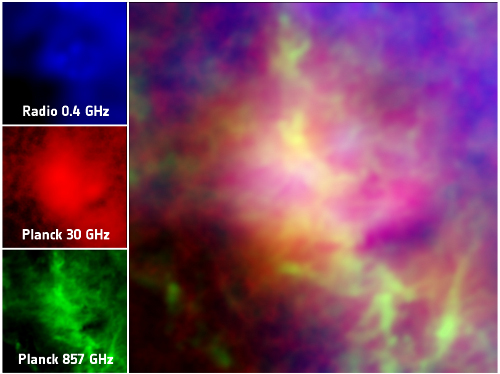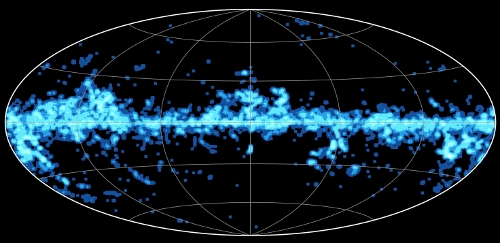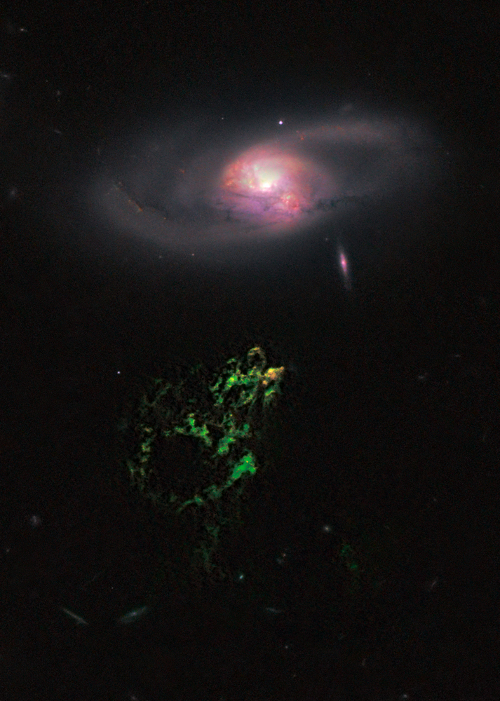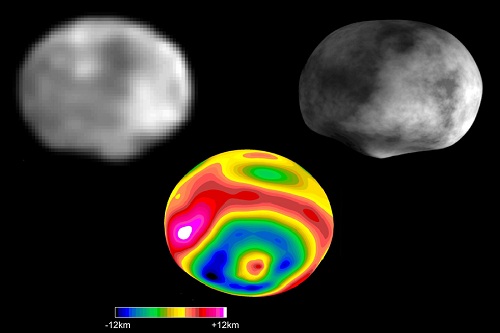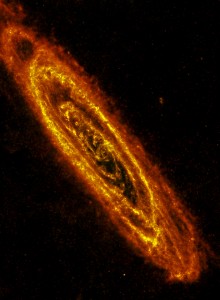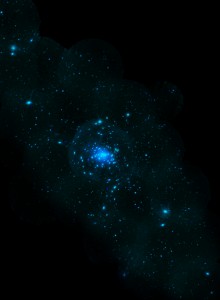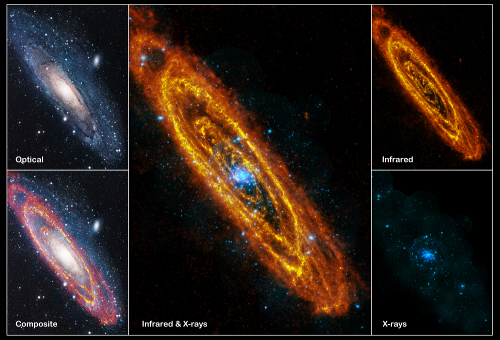Centauri Dreams
Imagining and Planning Interstellar Exploration
Planck Looks at the Interstellar Medium
Yesterday’s news conference on the Planck mission, held at the Millimeter and Submillimeter Sky in the Planck Mission Era conference in Paris, was so absorbing that I abandoned previous plans and stayed glued to the monitor most of the afternoon, replaying particular points from the various presenters (although keeping an eye on AAS happenings via Twitter as well). The video is available here, and it’s well worth a look given Planck’s interesting results so far, and the rich study of the Cosmic Microwave Background that will eventually flow from its data.
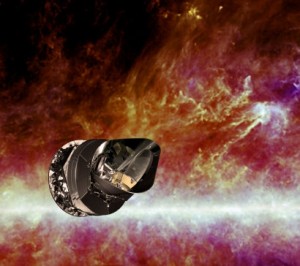
The European Space Agency has been offering broad coverage of the Planck findings, but before you check these out, bear in mind that the primary mission of the spacecraft is to measure the fluctuations in the CMB that both COBE and, to a higher level of detail, WMAP observed. It was fun to watch the sparring between the assembled Planck team and journalists at the conference when the question of data release came up. We won’t have the inside information on the CMB for another two years or so, the scientists arguing that such detailed work takes time (they’re right) and the journalists clearly looking for a bit of controversy.
Image: An artist’s impression depicts Planck against a background image of the Large-scale structure in the Milky Way. Credit and copyright: ESA.
Right now, though, Planck is engaged in a vital first step, which is to filter out the foreground emissions of cosmic structure located between us and the CMB. That means everything from galactic clusters to individual galaxies, gas and dust on large and small scales. And you can see where this leads — to filter out these factors, we have to study them with great precision, which is good science in itself and leads to yesterday’s discussion of the catalog of individual compact sources that Planck has made possible, along with maps of the galactic diffuse emission.
Anomalous Microwave Emission
But I want to focus on three aspects of the numerous Planck results announced yesterday, particularly its findings on the interstellar medium. If radiation from the ISM is a nuisance for cosmologists hoping to study the CMB, it’s a treasure trove of information for those specializing in the gas and dust in our own galaxy. And while dust in the ISM is known to shine at far infrared and submillimeter wavelengths, what we didn’t expect was a significant emission in the microwave band. First detected in the 1990s, this ‘Anomalous Microwave Emission’ (AME) has puzzled astrophysicists ever since, but Planck is now offering up a solution.
Clive Dickinson (University of Manchester) led one analysis of Planck’s maps re the AME:
“We are now becoming rather confident that the emission is due to nano-scale spinning grains of dust, which rotate up to ten thousand million times per second. These are the smallest dust grains known, comprising only 10 to 50 atoms; spun up by collisions with atoms or photons, they emit radiation at frequencies between 10 and 60 GHz.”
Dickinson’s work focused on two star-forming regions in the Milky Way, the Perseus and Rho Ophiuchus molecular clouds, pointing to nano-scale spinning dust grains as being a major factor, and perhaps the only factor, in creating the Anomalous Microwave Emission. A second study, led by Jean-Philippe Bernard (Institut de Recherche en Astrophysique et Planétologie, Toulouse), looked at the AME as manifested in the Small Magellanic Cloud. Bernard’s team confirms the idea that spinning dust grains play a major role in the excess radiation.
Image: This three-colour composite image of the Perseus molecular cloud (displayed on the right) is based on the three individual maps (shown on the left) of the complex, taken at 0.4 GHz from Haslam et al. (1982) and at 30 and 857 GHz by Planck, respectively. The colour composite highlights the correlation between the anomalous microwave emission, most likely due to nano-sized spinning dust grains and observed at 30 GHz (shown here in red) and the thermal dust emission, observed at 857 GHz (shown here in green). The complex structure of knots and filaments visible in this cloud of gas and dust represents striking evidence for on-going processes of star formation. Credit and copyright: ESA/Planck Collaboration.
Dark Gas in the Interstellar Medium
But Planck isn’t through with the interstellar medium yet. Its results also help astronomers measure an excess of dust emission that is sometimes called ‘dark gas,’ one which Bernard, speaking at yesterday’s news conference, was quick to point out has no relation whatsoever to ‘dark matter.’ Instead, this ‘dark gas’ component seems to be molecular gas which has been hard to quantify because it contains too little carbon monoxide (CO). The latter molecule is used by astronomers to measure the amount of molecular hydrogen in the interstellar medium.
Bernard adds: “”We believe that this ‘dark gas’ may be associated with the periphery of dense molecular clouds, where energetic ultraviolet photons destroy the CO molecules but leave the H2 undisturbed.” All of which points to Planck’s sensitivity to the temperature and density of gas in the ISM, helping us study components that have been the subject of theory but, until now, not of observation. The ISM studies help us extend our knowledge of galactic evolution and, for those of us with a long-term perspective, help clarify the medium through which future spacecraft will have to pass as we push outward into the galaxy.
A Catalog of Cold Cores
Planck is also finding a new set of targets for other telescopes to observe, among them cold and dense clumps of matter that emit most of their radiation in the sub-millimeter region of the spectrum. The complete Cold Core Catalogue of Planck Objects (with the delightful acronym C3PO) contains over 10,000 objects, with the most reliable of these, some 915 objects, being compiled in the Early Cold Core Catalogue. We’re talking about some of the coldest places in the universe, the dark birthplaces of stars whose formation is in its earliest stages.
Some of these cores have temperatures as low as 7 Kelvin (to see them, Planck’s detectors were chilled to 0.1 Kelvin), and as a by-product of their investigation, we wind up with a map of the coldest dust distribution throughout the Milky Way. Ludovic Montier (Institut de Recherche en Astrophysique et Planétologie, Toulouse) led the team that compiled and analyzed the C3PO sample:
“Instead of the compact cores that we expected to find, we have detected mainly objects which are rather elongated and have very low temperatures, between 7 and 16 Kelvin. These clumps are not isolated but appear to be all linked to one other, forming huge filamentary structures.”
Image: This map shows the density of cold cores in the Milky Way as detected by Planck during its first all-sky survey through its three highest frequency channels. Cold and dense clumps of dust, the coldest agglomerations of matter found within molecular clouds, are extremely important in order to understand the earliest phases of the formation of stars. Credit and copyright: ESA/Planck Collaboration.
The cold clumps tend to cluster along the Milky Way’s plane. Here’s Mika Juvela (University of Helsinki), who co-led the investigation with Montier:
“The majority of the cold material detected by Planck is either organised in filaments or located at the illuminated edges of pillars of dense gas. In addition, by combining the data with other observations we found that these cold clumps are aligned with hydrogen gas shells and other galactic regions of active star formation, supporting the scenario that the formation of stars might be triggered by earlier stellar populations.”
While Planck lacks the resolution to look deeply into the cores inside these cold clumps of matter, its work now feeds into future infrared observations by the Herschel instrument. Early Herschel work into a small number of the Planck detections has already been completed, but the Early Cold Core Catalogue offers hundreds of objects for further investigation. Understanding how cold dust factors into star formation helps us connect what we see in the Milky Way with broader galactic evolution.
That last point is significant because we’re talking about cold dust that has previously gone undetected in the study of local galaxies. Now we know that galaxies radiate more energy at far infrared and sub-millimeter wavelengths than we had assumed, and that changes how we draw conclusions about our observations of far more distant galaxies. Extremely cold dust is a clue to the history of star formation, giving us plenty to do as we wait for the Planck team to remove the veil from Planck’s whole-sky view and tell us what it has learned about the CMB.
The Planck Early Release Compact Source Catalogue, containing the Early Cold Core Catalogue, is available here.

AAS: Rocky Exoplanet and a ‘Voorwerp’
We’re exoplanet-minded around here, and any news from Kepler or CoRoT almost automatically goes to the top of the queue, but there are days when the visuals take precedence. Such was the case yesterday, when even as we learned about a small, rocky planet in Kepler’s view, we also received the image below, released at the American Astronomical Society’s 217th meeting. It’s Hanny’s Voorwerp, named for Hanny van Arkel, the Dutch teacher who discovered the celestial anomaly in 2007 while working with the Galaxy Zoo project. Here it’s seen through the Hubble Space Telescope’s Wide Field Camera 3 and Advanced Camera for Surveys, and what an image it is.
Image: This bizarre object, dubbed Hanny’s Voorwerp (Hanny’s Object in Dutch), is the only visible part of a 300,000-light-year-long streamer of gas stretching around the galaxy, called IC 2497. The greenish Voorwerp is visible because a searchlight beam of light from the galaxy’s core illuminated it. This beam came from a quasar, a bright, energetic object that is powered by a black hole. The quasar may have turned off about 200,000 years ago. Credit: NASA, ESA, W. Keel (University of Alabama), and the Galaxy Zoo Team.
This green, gaseous blob floating in space near a spiral galaxy looks for all the world like the cover of a science fiction magazine — I can almost imagine a couple of story titles and a publication name superimposed over the image. What are we looking at? Evidently the nearby galaxy (IC 2497) produced a quasar that sent a beam of light in the direction of the object — the bright green color comes from glowing oxygen. What makes the image so remarkable is that the quasar itself evidently turned off in the ‘recent’ past, within 200,000 years or so, so Hanny’s Voorwerp displays for us the quasar’s afterglow, along with now visible signs of star birth in the galaxy-facing region.
William Keel (University of Alabama in Tuscaloosa) led the Hubble study:
“This quasar may have been active for a few million years, which perhaps indicates that quasars blink on and off on timescales of millions of years, not the 100 million years that theory had suggested.”
Adding to the eerie quality of the photograph is that while Hanny’s Voorwerp seems to be an island of gas floating in space, it’s now known through radio studies that it is part of a long, twisting rope of gas, a 300,000 light-year long tidal tail that wraps around the galaxy, with only the Voorwerp itself being optically visible. All this points to a billion-year old galactic disruption in IC 2497, which is about 650 million light years from Earth. A possible culprit is a galactic merger, which would have expelled gas from the galaxy while simultaneously funneling gas and stars into a central black hole, which would have powered up the quasar.
Small Planet, Hot Orbit
A feast of ideas and imagery inevitably marks each AAS meeting, which makes following the proceedings on Twitter (search for #AAS217) a lively pastime, and one that can become a fixation as the tweets pick up their pace. The action was fast and furious yesterday not only as William Keel’s session on Hanny’s Voorwerp approached, but also when the Kepler mission confirmed the discovery of a small rocky planet, Kepler 10-b. We’re starting to see the emphasis on small planets pay off, as this latest find is said to measure roughly 1.4 times the size of Earth.
But we’re still not talking about a planet in the habitable zone, for Kepler 10-b orbits its star at a distance some 20 times closer than Mercury is to our Sun, with an orbital period of 0.84 days. Because high frequency variations in the star’s brightness caused by stellar oscillations (‘starquakes’) can be readily detected on this bright star, its properties are under active study and help to tell us more about the new planet. Scientists believe that it’s a rocky world with a mass 4.6 times that of Earth, with an average density of 8.8 grams per cubic centimeter. That points to a higher metal content than Earth, and a composition of solid silicate and metal grains.
Here’s Kepler mission co-investigator Natalie Batalha (San Jose State) on the find:
A Science News story quotes Diana Valencia (Observatoire de la Côte d’Azur) as saying “I would call it a rocky planet, and I would say it is more like a super-Mercury” than a super-Earth. With temperatures hot enough to melt iron, the star-facing side of the planet is likely covered with seas of lava.
For all the good news that the discovery represents — and it’s a heartening sign that Kepler is on course to find those rocky planets in the habitable zone that so many believe are out there in abundance — Kepler 10-b is not, as is being widely reported, the smallest planet ever discovered outside our Solar System. That honor goes to PSR B1257+12A, a ‘pulsar planet’ some 980 light years away in the constellation Virgo. That object is about twice as massive as our own Moon, a small planet indeed, but the same pulsar has yielded an even smaller candidate, PSR B1257+12 D, which is more or less the size of a Kuiper Belt object in our own Solar System.
True, pulsar planets circle stellar remnants and are obviously well off the main sequence, but they do give us interesting confirmation of the ubiquity of planetary systems. Meanwhile, the hunt for small, rocky worlds with climates far more moderate than Kepler 10-b continues.

Breakthrough Concepts: A Propulsion Overview
Speaking at last fall’s International Astronautical Congress in Prague, Tau Zero founder Marc Millis offered a condensed summary of the present state of the art in advanced propulsion physics, summarizing a variety of approaches and next-step questions from the book he co-edited with Eric Davis called Frontiers of Propulsion Science (2009). He’s now written a paper based on the presentation. It’s a useful distillation of an extremely detailed work (739 pages) and well worth scanning now that Millis has made it available on the arXiv site.
Quite a few propulsion concepts have gone through the early stages of the scientific process, with problems defined, data being collected and hypotheses formulated, and Millis also refers to those cases where ideas have progressed into the testing stage. He’s fascinated with the idea of using investigations into broad issues of cosmology to focus in on something far more utilitarian, the possible relevance of new observations for spaceflight. From the paper:
While general science continues to assess cosmological data regarding its implications for the birth and fate of the universe, a spaceflight focus will cast these observations in different contexts, offering insights that might otherwise be overlooked from the curiosity-driven inquiries alone. Homework problems to help teach general relativity now include warp drives and traversable wormholes. Even if there are no spaceflight breakthroughs to be found, adding the inquiry of spaceflight expands our ability to decipher the lingering mysteries of the universe.
Focus on the ‘Space Drive’
The approaches gathered in Frontiers of Propulsion Science are too numerous to list here, but let’s focus for a moment on the issue of space drive physics. A space drive is the umbrella term used to describe the interactions between a vehicle and surrounding space to induce motion, the key point being that such a technology, if ever developed, would eliminate the need for propellant. That’s a big issue — if we could move a craft in this way, we would be dropping the energy requirements from exponential to squared functions of trip velocity, opening up a wide range of mission possibilities we simply cannot achieve with rocketry or space sails.
Notice that the space drive is fundamentally different from what is more and more known as a ‘warp’ drive, the point being that the space drive interacts with spacetime rather than warping spacetime. Quoting Millis again:
Warp drives and wormholes are rooted in the Riemannian geometry of general relativity, where sufficient energy densities can warp spacetime analogously to how a huge gravitational mass bends spacetime. In contrast, most space drive concepts begin with Newtonian representations where the operative goal is to interact with reaction mass embedded in the properties of spacetime. This also implies, therefore, that space drive concepts will be light-speed limited since they operate within spacetime.
In other words, a warping of spacetime, if possible, would allow the craft to take advantage of the fact that there is no speed-of-light restriction when it comes to the expansion of spacetime itself (a notion that draws on cosmic inflation in the Big Bang era). The space drive is a different animal, and it compels a different kind of research. The primary issues are conservation of momentum and net external thrust, with the concept raising huge questions about the sources of inertial frames, the nature of the quantum vacuum energy, and the physics of photon momentum in media.
Our understanding of inertial frames is not complete, and various versions of Mach’s principle exist in the literature — speculating that inertial frames are the result of surrounding matter — with issues that remain unresolved. Nor is our understanding of vacuum energy complete. In fact, says Millis, “Depending on factors chosen for the calculation, the equivalent mass density of the quantum vacuum energy can span from the insignificant 10-26 kg/m3 to the enormous value of 1098 kg/m3.”
From Quantum Physics to Cosmology
The extension of quantum physics to cosmological scales is obviously a work in progress, with numerous approaches still in play. Will practical applications one day flow from their reconciliation? We can’t know, but Millis believes that adding the desired propulsion and power goals to these studies offers a useful additional perspective.
Over three dozen concepts toward breakthrough propulsion and power are addressed in this paper in a complex table that reflects the content of Frontiers of Propulsion Science, categorized by the challenges they address and their respective methods, and drawing on the ‘grand challenges’ addressed by NASA’s Breakthrough Propulsion Physics project, which Millis ran from 1996 to 2002. His paper goes on to offer up a challenging set of approaches matched with ideas about the unfinished physics they provoke, along with suggestions for next-step research. Many of these are general themes rather than specific tasks — to cite a few from his lengthy list:
- Explore vacuum energy experiments using negative index of refraction materials, ultra-high electrical carrier density materials and superconductors
- Determine if measurable effects are possible using ultra-high intensity tabletop lasers to test the space-warping assertions from general relativity
- Independently repeat or devise new experiments to explore Martin Tajmar’s unconfirmed observations of inertial frame dragging related to rotations of ultra-cold matter
- Revisit prior theoretical attempts to mature Mach’s principle into testable theories, but now including the following natural observations that were not known at the time of those earlier attempts: the absolute frame reference from the Cosmic Microwave Background radiation, anomalous trajectories of deep space probes, and the anomalous observations that lead to the Dark Matter and Dark Energy hypotheses.
And so on. Systematic and rigorous research can flow out of all this, but we have no way of knowing whether future discoveries in these areas will reveal new methods to help us cross interstellar distances at speeds faster than we can create through presently understood methods. The challenge is open-ended and energizing. Adds Millis: “Progress is not made by conceding defeat. With a combination of risk-taking vision and impartial rigor, useful, reliable results will accumulate.” Those results may or may not offer us a route to the stars, but they will help us discover things about the universe we need to know, a worthwhile outcome in the best tradition of scientific research.
The paper is Millis, “Progress in Revolutionary Propulsion Physics.” Preprint available.
Related: My article “Tau Zero Takes Aim at Interstellar Propulsion” is now available on the Discovery News site.

Looking Inside Vesta
The near-Earth asteroid 1999 AT10 is telling us a greal deal about an object much further away, the main belt asteroid Vesta. And that, in turn, is giving us new information about planet formation more than 4.5 billion years ago, when our Solar System was forming. The recently published paper, which precedes the August arrival of the Dawn spacecraft at Vesta, draws on infrared studies of 1999 TA10 by researchers from the Max Planck Institute for Solar System Research and the University of North Dakota, using the Infrared Telescope Facility on Mauna Kea.
The recent research compares the infrared radiation from the near-Earth asteroid to the spectral signature of Vesta. The latter, 525 kilometers in diameter, is quite an interesting object. It’s associated with a type of meteorite called HEDs — Howardite-Eucrite-Diogenite — which are thought to have originated in Vesta’s crust, traveling to Earth as the result of a huge impact that has left a crater on the asteroid’s southern hemisphere. Some of these meteorites (and about 5 percent of all falls are HEDs) have rock similar to what is found in Vesta’s mantle, but 1999 TA10 is the first near-Earth ‘Vestoid’ to have been found that matches Vesta’s mantle composition.
A mission backgrounder published in Acta Astronautica (reference below) notes the significance of the HED meteorites to the overall Dawn mission:
Comparison of re?ectance spectra suggests that achondritic meteorites known as HEDs (for their principal constituents of howardite, eucrite, and diogenite, all of which are magmatic rocks that form at high temperatures) are fragments of Vesta. Con?rmation of this important possibility would lend great weight to the use of laboratory studies of HED meteorites to contribute to the development of a description of Vesta’s structure and evolution. Discovering the geological context for the HED meteorites is, thus, a key objective for Dawn.
Image: On its southern side the asteroid Vesta shows a huge crater. This picture shows the asteroid in an image taken by the Hubble Space Telescope (top, left), as a reconstruction based on theoretical calculations (top, right), and as a topological map (bottom). Image: Ben Zellner (Georgia Southern University) / Peter Thomas (Cornell University) / NASA
The researchers believe, then, that the near-Earth object comes not from the outer rocky crust of Vesta but from deeper layers inside. With Dawn on the way, it should be possible to determine the thickness of Vesta’s crust and study its internal structure. The work has implications for planet formation, for Vesta has a differentiated inner structure, with a crust of cooled lava over a rocky mantle and an iron/nickel core. The similarity of this structure to terrestrial planets like Earth and Mars leads to the supposition that Vesta is a protoplanet, a still surviving relic of the ancient age when our system was beginning to come together.
The infrared studies found calcium-rich wollastonite and iron-rich ferrosillite, a fact whose significance is explained by Andreas Nathues (Max Planck Institute for Solar System Research), who notes that 1999 AT10 has a much lower concentration of iron than other Vestoids:
‘‘These materials can be found in Vesta’s mantle and crust. However, the ratio is decisive. This all points to 1999 TA10 having originated from the interior of Vesta.”
The crater at Vesta’s south pole is believed to be about 25 kilometers deep, which the new work suggests would be the maximum thickness of the outer crust. Understanding the thickness of the respective layers of Vesta’s geology should help us calculate the materials from which the protoplanet was formed, and by implication tell us about the kind of materials present when the entire Solar System emerged, and their relative ratios. Dawn’s visit to the remnant protoplanet will allow us to consider our hypotheses at length, for the spacecraft is scheduled to orbit Vesta for an entire year before moving on to Ceres.
The paper is Reddy et al., “First fragment of Asteroid 4 Vesta’s mantle detected,” in press at Icarus, published online on December 5, 2010 (abstract). For an overview of the Dawn mission, see Rayman et al., “Dawn: A mission in development for exploration of main belt asteroids Vesta and Ceres,” Acta Astronautica 58 (2006), pp. 605-616 (full text).

New Views of Andromeda
With the American Astronomical Society getting ready to convene its 217th meeting in Seattle on the 9th, it seems fitting to talk about one of the most splendid ‘nearby’ stellar objects, the Andromeda Galaxy, otherwise known as M31. Edwin Hubble was the first astronomer to resolve individual stars in the galaxy, but working with Milton Humason, he did something even more significant, studying Cepheid variable stars inside it whose brightness varies in a regular pattern that indicates their absolute magnitude. These ‘standard candles’ made it possible to find M31’s distance, which Hubble showed was much greater than that of any stars in the Milky Way.
We were learning in Hubble’s day that the ‘spiral nebulae’ once thought to be part of our own galaxy were distant ‘island universes’ in their own right, a vast expansion of the size of the cosmos as humans understood it. M31 is the closest spiral galaxy to ours at roughly 2.5 million light years, offering up a spectacular view of as many as one trillion stars (according to 2006 Spitzer Space Telescope data). It’s also alive with star formation in ways that recent ESA images from both the Herschel and XMM-Newton space observatories are showing us.
This is a new Andromeda, the image above being the Herschel view of the galaxy in the far-infrared, showing us clouds of dust and gas where stars can form. Moreover, the Herschel imagery shows not only a large ring of dust about 75,000 light years across that circles M31’s center, perhaps the result of a collision with another galaxy, but a number of other concentric rings of dust that will doubtless contribute to further star formation.
Image (above): This is the most detailed image of the Andromeda Galaxy ever taken at far-infrared wavelengths. The Herschel infrared space telescope captured the image during Christmas 2010. The large rings of dust that encircle the center of the galaxy may be the result of a smaller galaxy having collided with Andromeda some time in the past. Credits: ESA/Herschel/PACS/SPIRE/J. Fritz, U. Gent.
The contrast with the XMM-Newton data could not be more striking. XMM-Newton works with X-ray sources, and the imagery here is suggestive of stellar death as gas falls through space, heats up and gives off X-rays. Many of these X-ray sources are clustered around the center of the galaxy and indicate shockwaves and debris from exploded stars, or gaseous materials being sucked up by white dwarfs from stellar companions in what often ends up as a Type Ia supernova. In each case, we’re looking at wavelengths not visible from the surface of the Earth, images that tell us much about the living evolution of a massive city of stars.
Image: This image of the Andromeda Galaxy was taken by XMM-Newton during Christmas 2010. It shows hundreds of X-ray sources within Andromeda, many of them clustered around the centre, where the stars are densest. Each one is a dying star system. The sources can be shockwaves and debris rolling through space from exploded stars or pairs of stars locked in a gravitational fight to the death, in which one strips the other of precious gas. Credits: ESA/XMM-Newton/EPIC/W. Pietsch, MPE.
Below is a composite image showing views of M31 in various wavelengths for comparison.
Credit: Infrared: ESA/Herschel/PACS/SPIRE/J. Fritz, U. Gent; X-ray: ESA/XMM-Newton/EPIC/W. Pietsch, MPE; optical: R. Gendler.

Sails and Infrastructure: Thinking Big
Suppose we have developed an Earth-Moon industrial system, one that lets us use an electric launch system on the Moon to upload mass for chemical processing and the extraction of raw materials. What’s the next step toward extending it to the entire system? One idea, as Joseph Friedlander has been explaining on the NextBigFuture blog, is to do interesting things at the L4-L5 points, where stable gravitational pockets exist. Friedlander is thinking about building solar sails in space, and in this regard he echoes nanotechnology maven Eric Drexler, who wrote about sail technologies in The Engines of Creation (1986). Here’s Drexler on the subject:
To build lightsails with bulk technology, we must learn to make them in space; their vast reflectors will be too delicate to survive launch and unfolding. We will need to construct scaffolding structures, manufacture thin-film reflectors, and use remotely controlled robot arms in space. But space planners already aim to master construction, manufacturing, and robotics for other space applications. If we build lightsails early in the course of space development, the effort will exercise these skills without requiring the launch of much material. Though vast, the scaffolding (together with materials for many sails) will be light enough for one or two shuttle flights to lift to orbit.
The term ‘lightsails’ needs clarification. What Drexler means by it is a solar sail of higher performance than early sails. The latter will be made on Earth in sturdy enough fashion to survive not just launch but deployment. Drexler is interested in how to make sails bigger, and thinner. Why not use the lunar materials, then, to create what Friedlander calls a ‘gigantic solar sail loom,’ one that would stretch reinforcement wires in loom fashion over a framework that could reach 10 by 10 kilometers in size. The idea for this space shipyard is to create vast solar sails, spreading a volatile material on the framework, vaporizing thin amounts of aluminum onto it, then removing the volatile and support structure to create an ultra-thin, 100-square kilometer sail.
Sails as Asteroid Catchers
Friedlander’s interesting take on all this is well worth reading, and I’m especially pleased that he points to Al Globus’ idea of an asteroid-retrieval project called AsterAnts. Globus and colleagues Bryan Biegel and Steve Traugott (all working with MRJ Technology Solutions at NASA Ames) came up with the notion back in the late 1990s, presenting it as a NASA technical report and developing its ideas in a presentation at Space Frontier Conference 8. The notion is to retrieve small (1/2 to 1-meter) Near Earth Objects for orbital processing, and to do all this with solar sails that could be constructed and tested near the International Space Station.
Globus and team make the point that these small NEOs have a mass roughly equal to recent spacecraft (the paper cites Deep Space 1 and NEAR), some 500 kg, and thus should be manipulable with propulsion systems like solar electric. Small NEOs are numerous — the only problem may be detection — but it’s clear they could be useful because they include a wide variety of materials, including water, volatiles, and metals in large quantities. Globus mentions the never-built JPL design of an 820×820 meter sail meant to rendezvous with Halley’s Comet, and then runs the numbers on using square sails to retrieve a 500 kg object.
The result: Even with low acceleration, the sails need to be 200 meters to the side. But he also comes early to the realization that building a sail in an orbit as low as the ISS’ could be problematic:
It should be noted that solar sails cannot operate below about 1000 km since atmospheric drag exceeds the acceleration due to sunlight. Orbits between approximately 1000 km and 20,000 km are subject to high radiation… Thus, solar sails built at the ISS would probably need to be moved to a 1,000+ km orbit by chemical, tether, or solar electric propulsion or construction must take place in a 20,000+ km orbit. Worse, aerodynamic pressure on large sails may pose a hazard to the ISS. Detailed engineering would be required to choose a proper site for sail construction, but a design where spars and rigging are assembled at the ISS then moved along with rolled sail material to a teleoperated facility in high orbit for final assembly may be advantageous.
What is intriguing about this project is the idea of using existing space installations like the ISS for early experimentation on meteoroid processing and solar sail construction. Although we want to construct full-size sails in higher orbits, smaller sails could be built in a low-Earth orbit facility to develop the needed construction techniques. Deployment of a solar sail is perhaps the trickiest aspect of the technology, but ground-built sail material delivered to orbit and unrolled onto spars and rigging there would teach us much about how to build larger sails, with the eventual goal of working with thinner sail materials actually produced in space.
We need, then, to understand how thin films behave in weightless conditions and what sort of manufacturing techniques we can develop to make them thinner still. From the report:
To build solar sails on-orbit, tens of thousands of square meters of thin-film aluminum must be produced. Clearly, this would require a large, dedicated facility outside of the pressurized ISS volume. However, experiments to understand the behavior of thin-films in weightlessness and to develop manufacturing techniques could be conducted in the pressurized volume. For sail making, one approach is an electroplating technique, where a large drum is continuously plated with evaporated, charged aluminum on one side, and the solidified sheet is peeled off the back side of the roller. A more elaborate mechanism, credited to Eric Drexler, appears in [Wright 1992].
The reference is to Jerome Wright’s Space Sailing (1992). Friedlander, meanwhile, extends the AsterAnts idea to the kind of lightweight sails Drexler writes about, going after 1000-ton asteroids with an infrastructure encompassing entire fleets of sails, one that would begin to produce a billion tons a year of returned materials in high-orbit. In such a scenario, solar sails obviously reach a high level of development, enabling interplanetary travels that help us create the kind of system-wide infrastructure that may one day lead to interstellar missions. If you want to think big, check out Friedlander, who concludes with a discussion of a sail the size of Mercury.
Forward’s Delight
I can just imagine Robert Forward’s eyes dancing at the thought of such a sail. The patron saint of so many interstellar concepts loved big ideas. It was Forward, after all, who envisioned an enormous Fresnel lens in the outer solar system to focus an inner system laser that would drive a huge lightsail to Alpha Centauri and other nearby stars. Here I’m using the term ‘lightsail’ in Forward’s terms (not Drexler’s), meaning a sail that uses not solar photons but beamed propulsion from a man-made installation to get up to speed. Forward even worked out a way to use laser beaming to decelerate a mission at the other end, but that’s a tale for another day.
Meanwhile, AsterAnts intrigues me because we’re already doing many of the necessary first steps, including surveying for ever smaller Near-Earth objects and developing sail materials that will help us produce thinner and thus more effective sails. We’re also developing the needed computational tools to attack both sail performance and trajectory issues, autonomous operations and orbital material-processing questions. We may have but one functioning solar sail (IKAROS), but we can investigate many of these issues with high-power simulations.
And there are practical benefits. Globus notes that solar sails could increase the number of geosychronous satellite orbital slots by a factor of three. This is based on another Forward idea, to use a sail to hold a geosychronous satellite out of plane. Today’s geostationary satellites orbit at an altitude where they can revolve around the Earth at the same rate that the Earth rotates, and they have to be spaced 2-3 degrees apart to avoid radio interference. That amounts to 120 to 180 satellites for any particular frequency band, creating congestion over crowded areas.
A solar-sail ‘statite’ of sufficient size could ‘hover,’ tilted so that light pressure is equal and opposite to the pull of gravity, thus increasing the number of direct broadcast slots dramatically. All of this is by way of making the case that space can pay off in multiple directions. Developing the needed sail technologies to make some of these things happen points not only to a supply of interesting materials from captured asteroids but also to economic benefits that are closer at hand. It also points to a space future in which sails take us into the Kuiper Belt and beyond.

